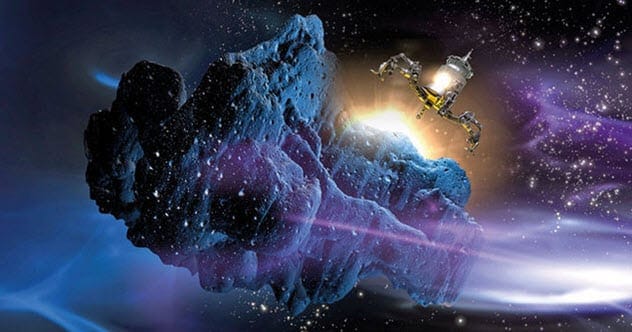Are you prepared for the next global-changing event? While we navigate through current challenges, a cosmic reminder looms as asteroids whiz past Earth. Let’s explore ten essential facts about asteroid collisions and what they mean for our planet.
10. Asteroid 2001 FO32
In March, a large asteroid, roughly a mile in diameter, dubbed Asteroid 2001 FO32, passed within 1.3 million miles of Earth. That’s about five times the distance between Earth and the Moon. Its size classifies it as potentially hazardous, as an impact would result in a global catastrophe. Being an Apollo-class asteroid, it intersects Earth’s orbit every 2.2 years, posing a recurring, albeit small, collision risk.
Notably, Asteroid 2001 FO32 isn’t the only space rock zipping past us. In January alone, nine asteroids came closer to Earth than the Moon.
9. What an Impact Would Look Like?
If Asteroid 2001 FO32 were to hit Earth, the consequences would depend on its size, composition, speed, and impact location. Imagine it hitting Berlin: the initial crater would be 10 miles in diameter and 3.6 miles deep. The ensuing explosion, 30 million times that of Hiroshima, would flatten buildings across Germany and cause destruction as far as Ukraine, Sweden, Italy, and France.
The impact would eject debris, blocking sunlight for weeks, causing a global temperature drop of 46 degrees Fahrenheit, resulting in crop failures and acid rain. If the asteroid landed in the ocean, it would create a series of tsunamis and vaporize seawater, damaging the ozone layer, increasing dangerous UV Lights exposure.
8. Near-Earth Objects
Asteroid 2001 FO32 is just one of many Near-Earth Objects (NEOs). In 1998, flawed calculations suggested Asteroid 1997 XF11 could collide with Earth, causing global panic. Though later debunked, this event led to the establishment of the Center for Near-Earth Object Studies (CNEOS).
As of 2020, this organization has identified 96% of potentially globally catastrophic NEO asteroids the size of Asteroid 2001 FO32 or larger. However, only 20-30% of regionally catastrophic asteroids have been located, meaning the locations of most smaller, yet still devastating, space rocks remain unknown.
NASA considers asteroids at least 140 meters in size that pass within 5 million miles of Earth as Potentially Hazardous Asteroids (PHAs). As of January 2021, 2,160 PHAs have been detected, with about 150 posing a global threat.
7. The Problem With the Number of Asteroids
While over a million asteroids have been detected, this is a small portion of the total number. Most reside in the Asteroid Belt between Mars and Jupiter. NASA estimates that about 100 tons of dust and small pebbles burn up in Earth’s atmosphere daily.
From 1994 to 2013, 556 asteroids (ranging from 3 feet to 60 feet) burned up in the sky as fireballs, averaging 28 per year, all undetected beforehand. Experts estimate around 17 asteroids/meteors large enough to reach the surface impact Earth daily, most landing in water or uninhabited areas—virtually all undetected.
6. The Tunguska Event

On June 30, 1908, a seismic event was recorded worldwide. Twenty years later, it was discovered that a remote Siberian area near the Podkamennaya Tunguska River had been flattened, with approximately 80 million trees destroyed across 830 square miles.
The prevailing theory suggests that a small asteroid or comet, approximately 150 to 300 feet in size, exploded 6 to 10 miles above Earth, creating a blast 185 times greater than Hiroshima and a fireball 164 to 328 feet across. This event highlights the potential devastation of even smaller, undetected asteroids.
5. The Problem with Small Asteroid Detection
It wasn’t until 2008 that humans successfully detected an incoming asteroid and predicted its impact location. Asteroid 2008 TC was discovered just 20 hours before its arrival by the Mt. Lemmon Observatory in Arizona.
The Minor Planet Center (MPC) confirmed it as a new object and calculated its impact point in the Nubian Desert in Sudan. Twenty-six observatories tracked the asteroid, predicting it would explode 23 miles above ground. The 1-kiloton explosion occurred precisely as predicted.
However, relying on Earth-based observatories presents challenges, such as weather limitations and the risk of facilities being out of service. In the 11 years from 2008 to 2018, only 3 out of 367 detected impacts were successful, indicating a less than 1% success rate in detection.
4. The Problem of Seeing Asteroids

Asteroids appear as stars until they move. Smaller asteroids reflect less sunlight, making them harder to spot. Ground-based telescopes are limited by cloud cover and light pollution, especially since most observatories are in the Northern Hemisphere.
Space-based telescopes like Hubble aren’t affected by these limitations but still struggle with smaller asteroids. Infrared telescopes, which detect heat, help, but they have difficulty distinguishing between the Sun’s heat and an asteroid’s when the asteroid is between Earth and the Sun. The Chelyabinsk meteor in 2013 highlighted these detection challenges.
3. The Chelyabinsk Meteor
On February 15, 2013, a 65-foot asteroid exploded 14 miles above Chelyabinsk, Russia, with a force of 500 kilotons, 30 times brighter than the Sun. The shock wave shattered windows, injured 1,500 people, and marked the first verifiable impact in history to cause injuries.
Despite being larger than the asteroid detected in 2008, experts claimed it was too small to be seen and came from the East with the sun behind it, complicating detection.
2. The Problem With Predicting Impacts
Relying on averages for asteroid impacts can be misleading. Averages suggest a dinosaur-killing asteroid hits every 100 million years, but the next one could come at any moment.
Smaller asteroids hit more frequently: a Tunguska-sized asteroid every 2,000 years and a Chelyabinsk-sized asteroid every two centuries. However, the exact timing of past large impacts is uncertain, making predictions challenging.
Probabilities depend on observations and orbital calculations. Many asteroids are briefly observed and then lost, making it hard to determine their threat level, and orbits can change, further complicating predictions.
1. The Problem of Stopping or Diverting an Asteroid
Various methods have been proposed to divert asteroids, including using gravity to tow them, pushing them off course, attaching mass drivers to hurl debris, superheating their surface with solar mirrors, or using nuclear explosions. NASA and the European Space Agency (ESA) are working on kinetic impactors, inspired by the Deep Impact mission.
NASA’s Double Asteroid Redirection Test (DART) will collide with a moonlet orbiting the Didymos asteroid to test this method. The ESA’s Don Quijote mission aimed to survey and impact an asteroid, but it remains in development. These solutions require significant warning time, which may not always be available.
From potentially hazardous flybys to detection difficulties and possible diversion methods, understanding these key aspects is crucial for appreciating the ongoing efforts to protect our planet from cosmic threats.
What do you think about these potential threats? Leave your thoughts in the comments below!










